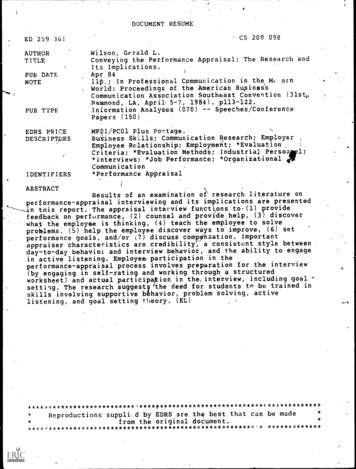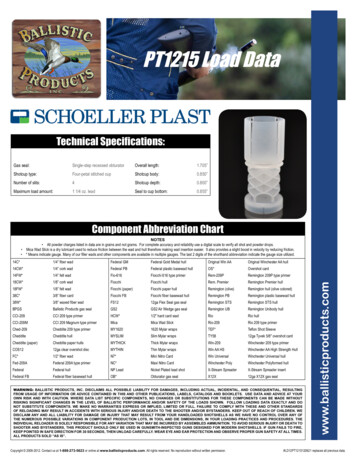
Transcription
DOCUMENT RESUMEED 259 361AUTHORTITLEPUB DATENOTEPUB TYPEEDRS PRICEDESCRIPTpRSIDENTIFIERSCS 209 098Wilson, Gerald L.Conveying the Performance Appraisal: The Research andImplications.ItApr 84llp.; In Professional Communication in the Mc ernWorld: Proceedings of the American Busines.sCommunication Association Southeast Convention (31st,Hammond, LA, April, 5-7, 1984). p113-122.Information Analyses (070) -- Speeches/ConferencePapers (150)MFAWPC01 Plus Postage.BuSiness Skills; Communication Research; EmployerEmployee Relationship; Employment; *EvaluationCriteria; *Evaluation Methods; IndustriLq Person*interviews; *Job Performance; *OrganizationalCOmmunication*Performance Appraisal/l;ABSTRACTtom-Results of an examination of' research literature onperformance-appraisal interviewing and its implications are presentedin tnis report. The appraisal interview functipns to,(1) providefeedback on performance, (2) counsel and provide help, (3). discoverwhat the employee is thinking, (4) teach the employee to solveproblems, (5) help the employee discover ways to' improve, (6) setperformance goals, and/or 0) discuss compOsation. Importantappraiser characteristics are credibility, a consistent style betweenday-to-day behaviol. and interview behavior, and the ability to engagein active listening. Employee, participation in theperformance-appraisal process involves preparation for the interview(by engaging in self-rating and working through a structuredworksheet) and actual participak ion in theeinterview, including goal 'setting. The research suggest the deed for students to be trained inskills involving supportive bhhavior, problem solving, activelistening, and goal setting theory. ***********1*************Reproductions suppli, d by EDRS are the best tha.t can be madefrom the original *************** ******k******
U.S. ENEPARTMEMIT OP EDUCAT3MIn Professional Communication in the Modern World:NATIONAL INSTITUTE OF EDUCATIONProcooainis of.the American Business ,C.(:)Itounication Association31st Southe,Ist Convention 1984r--4,prNCompiled and edited by Richard David RamseyHammond, Louisipna, U.S.A.Southeastern Louisiana' UniversityUNTERIFRICIha, beam reproduced semewed hmn the person tP Of galIMIKM'he, document04.0nogMinor changes have been made to Imp/cotfewodwiloncitidlityPINIIIIS Of WOW 01 opinions stated in thri document do not neceasenly represent officvelNIEPosItion or policy.1984 April 5 -7ON(\JEDUCATIONAL RESOURCES INFORMATIONCONVEYING THE PERFORMANCE APPRAISAL:THE RESEARCH AND ITS IMPLICATIONSPERMISSION TO REPRODUCE THISMATERIAL HAS BEEN GRANTED BYGerald L. Wilson, University of South AlabamaGerald L. Wilson.'ABSTRACTfi).TO THE EDUCATIONAL. RESOURCESINFORMATION CENTER (ERIC)."Ihis essay reviews the major research literature on performanceappraisnterviewing with respect to the function of appraisalinterviefrequency of interviews, appraiser characteristics,employee partiCipation, and'goal-setti.ng Conclusions are drawn'regarding appropriate practices and the teaching of performanceappraisal interviewing.,*fr.7,INTRODUCTION,.'The performance-appraisal interview ro;44es an intriguingcommunication situation for the student'Of brganizatTenal communication:'Employees undoubtedly need the feedback of their supervisor to do their.best.Yet they are often anxious at the prospect.of an appraisalinterview. On the other hand, supervisors recognize that employees wantto know how they are doing on the job.They also realize that they.should communicate with their employeet about Mork performance. Yet, inpractice; performance informatiqn is frequently not discussed withemployges (Burke &Kimball, 19;1). ,And,When,it is discussed it may begiven in a perfunctory manner (Porter., LaWler;*, Hackman,(1975). Inaddition, it has long been recognized.,that tote auperVisors avoidpe 7-rmance-appraisal interview ,wheriaasothers,experierce'anxiety and.dinfort in.doing them (McGr .4or,"057). Beyond this, the infrequentand ,.fective use of performance-appraisal interviews is Well,documented (Landy & Trumbo, 1984 McGregor,'195MeyeA'et al., 1965)The irony of this situation is that a performake-ap0ailal interview isa primary and important context for the7supervisOX':ftad employee to-work,together to achieve superior performance. Yet', fear keeps the 'processfroM achieving its full potential.'0tResearch 'on performance-apIlraisar interVieyinglrovides apromise of help for conducting these intrviews; but it is'broadlyscattered.This essay has a, twofold purpose. First,'draw'together what' is known from the researcti Aterature onperformance-appraisal interviewing. This literature will be groupedunder the headings of function, frequency, appraiser characteristics,'climate, and employee participation.Second, the imPlicaeionsof thisreserd. for teachers and scholars will be drawn.a.4
WL1,sonFUNCTIONS OF APPRAISAL INTERVIEWINGA quick survey of the writings of researchers And otherauthorities on appraisal interviewing shows a myriad.of expettations forfunctions of the'employee interview. The appraisal inter4ew mightfunction to provide feedbaCk on performance, to counsel and providehelp, to disCover what the emplayee is thinking,'to teach the employeeto solve problems, to help the elployee'discover ways to improve, to setperformance goals, and/or todckusi compensation. The goals of theappraisal interview seem endless. 'The problem created by such multiplegoals is that an attempt to adopt a' set of reasonableigoals may be'ome,.difficplt for the interviewer. And without specific goals in mind theinterview may lack ,tie necessary focus,sto achieve anything oftconsequence.1One way to make this list more manageable and functional.tirtodivide the activities into two categories: employee development needsClearly what the employer is trying to do isand organizational needs.to help ehe employe! be more productive and satisfied with work as a:person to develop theftmployee, and to achieve the organizationsproduction goals and Organizational needs.',.Bdyond these two generally accepted functions, lies the ,questionof:discussing compensation as a function of the performanceappraisalinterview. Two studies havepecifically addressed the question ofwhether this ought'ito be a function of theiappraisal interview. Thefirst was conducted by Meyer et al. (1965) in donjuNtion with theTheseGeneral Electric Work'Planning and Performance Review Program.researchers concluded Nat trying tosachieve both feedback andcounselling for improvement and informing of a salary decision was lesseffective than,splitting the roleb and holding two separate interviews.They found that -the empintyea' attitudes toward their supervisor andPerformance improved whensthe,le two purposes were separated . Theirexplanation was that when thisd purposes were Combined in a singleinterview; the discussion of salary took-precedence in the thployee'smind over/a discussion of improvement. The result was that employeeswantO.to Make a good impression and/or justify a greater salaryincrease. Huse and Kay (1964) reported that'salary discussioncontributed significantly to the overall tension of the employees theyBoth topics--development and compensation--do not seemstudied.particularly compatible., The arguMint that they do not fit iscompelling, but there were 'several ,confounding factors in theseresearchers' design. Primarily., the-pioblem was that the interviewsThey t4ere,when separated' differed in'other important respects.different in that they were more frequent, emphasized joirip goalplanning, and had no summary ratings.Cummings (1973)'-conducted a s udy which sought to test, thisrelationship in the field. He argue that expectancy theory suggalstsinterview. His field experimentthat salary be a part of an appraisTheinvestigated employee reactions to ah old and new appraisal system.data indicated/that lemployees had more positive attitudes to the newsystem that joinItly0addressed development and salary than to the oldtr
Wilson115system that did not. Again the experim&nt was confounded by factor§that do ,not' permit confidence in this conclu61on.FREQUENCY,Miner (1974, .i75) reported frequence data for performanceappraisal interviews from a 1974 Bureau of National Affairs' survey ofpersonnel managers of 150 industrial and government organizations.Ninety percent of their managers,' Office personnel and produ4ion',.workers were appraised yearly. Additionally, perfOrmance-a Praisalinterviews were conducted in about 9,0 perrent of the cases where,performance appraisals were made.,.,However, these data may be misleading. The problem oecomes oneof discovering what 'is meant by a performance-appraisal interview. Hall,and4pawler (1969) 'report that the supervisor and subordinates sometimesha0 different Views as to what constitutes an interview% Questioningconducted with both, groups revealed that the supervisor thought of abrief, general discussion with a subordinate as A performance-appraisalinterview, wheiedg.subordinates did not see it as such.,Other iesearchers hrave uncovered practices that place thisself-report data in doubt. McCall and DeVries (1976) and Meyer, et al.(1965) discovered that supervisors resisted holding performanceappraisal interviews unless the organization took specific measures toLandy and Trumbo (1980) report that 'among ainsure that they were held.number of companies they studied interviews were frequently.iot held toconvey ratings because superviiors believed that doing so wasinconvenient logistit.#11y or they believed that the ratings served no Lreal purpose.)Recommended 'frequency has been an issue of concern anddiscussion among 'scholars. Three factors have been'suggested asdeterminants of frequency: the nature of the goal' of the interview, the','kind of position the employee has in the organizatioli, and theCummings&Schwab.(1978)choracteritties of the employee's performance.suggest that a maintenance interview is all that is necessary' or someThese people a re those in routine jobs, whose record of-;employees.performance is satisfactory. This same rule seems reasonable forlOng-time employees who are adequately performing. These employees havehad the, opportunity to refine their job skills and show consistent,performance; thus they do, not require frequent reviews (Kane & Lawler,-.1979).There is evidence, though, that emprloyees ought to be interviewed atleast once each year. Landy, Barnes,and Murphy (1978) indicated thatpersonnel who were evaluated at least once each year thought theirevaluations were fairer and more accurate than those who were evalbatedBut, when employee development is the function of theless frequently.interview, when the job is nonr lutirle, and when goal-settingis part of theinterview, more,frequent interviews are recothmondt!d (McConkie, 1979;Cummings & Schwab, 1978; Meyer et al., 1965).
JI.41 Li sonFinally, Cummings and Schwab suggest frequent reviews for theorganization's low performers. They recommend weekly (andi.indifficuitcapes, dailyl-interviews to monitor and give feedback on employee,.performance. More, rather than fewer, interviews allow the interviewerto focus more. specifically and on fewer negftive issues.And if Kay-Jetal. (1965) are correct, the focus on fewer negative issues will improvethe crimate.f6t Lmprovement.APPRAISER CHARACTERISTICSOne characteristic of the appraiser that is directly associatedwith effectiveness is credibility. Credibility in this case relates tothe appraiser's' knowledge.of the employee's Job dutieseand behavior.Ilgen, Fisher, and Taylor (1979) conducted a thorough review of theliterature on feedback in organizations. Their conclusionwith respectto the appraiser's knowledge of the subordinate's job and behavior isthat the suboidinate views the feedback as more accurate and thereforeis more willing to accept it when the,source is knowledgeable.Landy etal. (1978) came to a similar conclusion. They found that the"subordinates who believed, their supervisors to be - highly knowledgeableabout these two factors tegarded the interview as more fair and accuratethan did their counterparts who viewed their supervisors as-lessknoWledgeable.-A'second characteristic of the appraiser that seems to beimportant is consistent style between day-to-day behavior and thatbehavior demonstrated in the interview (French et al., 1966; Bassett &Meyer, 1968). 'A supervisor who wishes to engage in prpblem solving with,employees in the appraisal interview,. but has taken on the role of judgein day-to-day interaction with employees about their jobs, is being.inconsistent. Meyer et al. (1965) urge managers to adopt the role ochelper rather than the role of judge both.in their day-to-dayinteraction and in performance xeview sessions.A final important characteristic of the appraiser is the abilityto engage in active listening. Kikoski and Litterer (1983) contend theability to paraphrase content back to the speaker and to reflectfeelings, the two basic.skills of active listening, contribute to theappraiser's effectiveness in appraisal iaterviews.They base theirclaim on 150 data-based stuilieNIvey & titterer, 1979) that sought toIdentify communication skills and assess their effectiveness.CLIMATEClimate in the performance-appraisal,interview has receivedconsiderable attention bo4h in well-reasoned arguments.and in empiricalresearch.Concerns have traditionally centered on praise, criticism,and the superior-subordinate relationship.
Wilson117Surprisingly, Meyer et\al. (1965) found that praise did not havemuch effect on the outcome of the appraisal. They concluded that"praise may be regardtd as the sandwich whic1 surrounds the raw meat"(p. 127).That is to say, the average subordinate may believe that thesupervisor's motivation for praising is preparation for the "bad news"Farson (1963) argued persuasively in Harvard Business Reviewto follow.that praise can also have a negative outcome. He.suggests that praisemight quite-)reasonably be viewed as threatening (1. e., a statement ofsuperiority and a constraint on the employee's creativity).An alternative to praise is plcouragement (Hanna & Wilson,Supervisors might.ask the employee to review her accomplishments1984).Thisand then affirm those that they believe to be accurate.affirmation is encouraging to the subordinate--the supervisor has agreed'Encouragement 8f this typewith him in.regard to his accomplisiments.avoids the sense that the employer may be pointing out accomplishmentsas aprelude to discussing inadequacies.'Criticism is a second factor that affects pellformance appraisalclimate. The supervisor cannot avoid discussing. shortcomings in theemployee's performance if the appraisal interview is to meetorganizational performance objectives. Research suggests that it isse that is problematic in the interview. Tooexcessive criticismmuch criticism appears to:trigger the employee's defense.mechanism andto destroy the climate for improvement (Bordonaro 19;6; Meyer et al.,1965). In fact, Greller (1975) reported that the more the managers hestuaWd criticized their employees, the less improvement was seen in thearea *-criticized. When similar areas were criticized lAT, managers,were able to'see owe improvement. In addition, there was a positi/ecorrelation between the number of critical comments and themumber-ofdefensive reactions noted.per/" Finally, the supervisor's sapportivp orientation has been shownto be helpful, in building an appropriate climate (Latham & Saari, 1979;1Burke et al., 1978; Nemeroff & Wexley, 1977;-Burke & Wilcox, 1969;Solem,T960). Nemeroff and Wexley (1977) conducted a study that showswhen managers take an attitude of helper - -they treat the employee as anequal, show respect for the employee as a human being--the employee ismore satisfied with both the session and manager than when the managerdoes not. Supportive, behavior has also been demonstrated to be relatedto higher performance goal-setting by the employee (Latham & Saari,1979).A quality relationship is also important to supportiveness.Kikoski and Litterer (1983) suggest that development of a qualityrelationship involves four communication behaviors: (1) acknowledging.the employee as a person, (2) indicating. that the manager understandsthe conditions under which the employee has labored: (3) conveying thatthe employee's, behavior is accepted, if not necessarily approved, and(4) letting the employee know that she has been listened to andunderstood.6
A'118WilsonEMPLOYEE PARTICIPATIONThe issue of employee participation has received considerableattention in the performance-appraisal interviewing literature.Employee involvement in the performance-appraisal process is usually,divided into,two areas:preparation and actual participation in theinterview, 'including goal-setting.PreparationaOne fOrm of preparation is self rating.Bassett and Meyer(1968) report that most managers expect that their employees produceratings thatare unrealistically favorable. Therefore, they arereluctant to base an appraisal discussion on self-appraisals. But,based on Bassett and Meyer's investigaltion of actual practice managersfind that employee's self-ratings are. surprisingly modest. Theresearchers attrib a this modesty to the fact that the self-appraisalis being publicl announced and that immodesty is not valued id ourculture.Burke et al. (1978) discovered thatthe,act of giving a worker astructured work sheet to usein personal'preparation was associated witha positive outcome for the interview. The object of the work sheet isto allow the employee time to reflect and prepare to participate.Thispreparation seemed to reduce the awkwardnesS of being asked questionsthat the employee couldlhot'answer without reflection.The content ofthe worksheet used by Burke and his associates asked the employee tosuggest principle responsibilities and problems encountered infulfilling these responsibilities, and then to describe and compare her/hispersonal performance with the performance of others who hold similar jobs.Participation in the InterviewAside from the actual participatthn itself, the "welcoming ofparticipation" seems to be important itself. Four studies (Burke etal., 1978; Nemeroff & Wexley, 1977; Greller, 1975; Burke & Wilcox, 1969)have shown correlations between such items as "boss asked my opinion"and "opportunity to present ideas and feelings" and a number of positiveoutcomes. Nemeroff and Wexley concluded frawr-their investigation thatthere seem to be two difficulties with welcoming performance:theobservation that supervisors seem to underestimate the importance of theopportunity for subordinates to participate and the degree to whichthey, the supervisors, invite participation effectively.Although results have been mixed, research points to the factthat, in general,'the greater the employee's participation in the'interview, the more satisfied the person will be both with the interviewand the supervisor (Nemeroff and Wpxley, 1977; Greller, 1975; Solem,1960; Maier, 1958). This statement must be tempered by severallimitatiops presented by researchers and scholars, Locke and Schweiger(1979) suggest that the new employee might not haVe sufficient jobknowledge to participiteThey also point out that some employeeshave a need%r dependence on' their supervisor.These employees enjoy
Wilson119being dependent and, therefore, are unlikely to have their ownsuggestions for improving their performance. French et al. (1966)indicate that the supervisor's usual style may have an effect on theemployee's willingness to participate., If the supervisor does notnormally welcome employee participation, then the employee is unlikelyto participate in the interview at a high level. Basset and Meyer(1968) reported similar findings with respect to ilqcongruent styles.Goal-SettingGoal-setting is a factor that has consistently been associatedwith positive outcomes in appraisal interviews. Two separate studies(French et al., 1966; & Basset and Meyer, 1968) have demonstrated thatsetting Specific goals for performance improvement yielded twice as muchimprovement as either setting general goals or criticism without goalsetting.Correlation studies of goal-setting have shown that it ispositively related to employee 'satisfaction with the interview (Burke etal., 1978; Greller, 1975, 19781 Burke & Wilcox, 1969), perceived utilityof, the appraisal'(Greller, 1978) and perceived fairness and accuracy ofthe evaluation (Landy et al., 1978). Goal-setting in performanceappraisal has also been associated with the employee's desire to improveand the later improvement (Burke et al., 1978; Burke & Wilcox, 1969),and with greater mutual understanding and perceived fairness (Burke etal., 1978).CONCLUSIONWhat conclusions can be drawn about factors that eithercontribute to or detract from effective performance-appraisalinterviewing?' First, it seems reasonable to conclude that mostinterviews should focus upon employee development needs andorganizational needs. The degree to which the inter3iewer chooses tofocus more on one or the other probably depends on whether the person isa new or-long--time employee and whether the job is such that goal-setting isappropriate, and on the individual's performance in the particular job.The new employee May need more development than the long-time employee.,A routine job may not lend itself to goal - setting. Individuals whoseklevel of performance is high may not need a strong emphasis in either ofthese areas. The research casts doubt upon the advisability ofdiscussing compensation in the performance appraisal interview.Untilfurther data are collected the argument seems to be in favor of thisconclusion.Recommended frequency for performance - appraisal interviews isbest determined by considering th nature of the goal of the interview,the kind of position the employee has in the organization, and thecharacteristics of the employee'performance. The general rule is thatan employee ought to be intery wed at least once each year. Whenemployee development is the unction of the interview, the job isnonroutine, and goal-settis a part of the interview, more frequentf
120Wilsoninterviews are recommended. Weekly reviews are recommended for theorganization's low achievers.,Another conclusion drawn from the research literature is thatthe supervisor must have specific knowledge of the subordinate's job and"The outcome. of credibility from this sourceduties to have credibility.is a perception by the interviewee that the review is more accurate and\.a greater willingness to accept it. The appaiser's effectiveness isalso affected by consistency in style and by active listening skills.(Research on climate centers on praise, criticism, andsuperior-subordinate relationships. -Praise seems to be an ineffectivestrategy in the appraisal interview. The interviewer should also, avoidtoo much criticism and foster a supportive relationship.'With respect to participation, the employee should be encouragedto prepare by engaging in self-rating and working through a structuredworksheet. Beyond this the interviewer shJuld be sure that theThe employee shouldinterviewee knows that participation is welcome.also be encourage1 to participate in goal-setting, if such an activityis indicated. The act of goal-setting'may lead ed"increasi!dperformance, a greater desire to improve, greater sOisfaction, greaterutility, andrgreater perceived fairness and accuracy.,-This research suggests several classroom training need forFirst, the strong correlation betweenorganizational members.supportive behavior and outcome suggests the need to train students in these skills. Second, the employee development aspect of theperformance-appraisal interview presents a need for.training in problemsolving. Third, the positive effect of active listening suggests a needfor students to develop this skill. Finally, the strong association ofgoal-setting with positive outcomes compels teachers of performanceappraisal to teach students goal-,setting theory.P.,-REFERENCESBassett, Glenn A., & Herbert H. Meyer. (1068). Performance appraisalbased on self review. Personnel Psychology, 21, 421-430.(1976).Bordonaro, Frank P.Horizons, 19, 76-81.The dilemma caused by praise.BusinessBurke, Ronald J., & L. Kimball. (1971). Performance appraisal: Someissues in the process. Canadian Journal of Personnel and IndustrialRelations, 18, 25-34.(1978).Burke, Ronald J., W. Weitzell, & Thomas Weir.Characteristicsof effective employee performance review and development interviews:Personnel Psychology, 31, 903-919.Replication and extension.Burke, Ronald J.Characteristics of effective& D.S. Wilcox.(1964).Personnelemployee performance review and development interviews.lcholoa, 22, 291-305.9
.121WilsonCummings, Larry L. (1973). A field experimental study of the effectsof two performance appraisal systems. Personnel Psychology, 26,489-502:'Cummings, Larry L., & Donald P. Schwab. (1978).Desi, ling appraisalsystems for information yield. California Management Review, 20,18 -25.Farson, Richard E. (1963).Review, 41,.(8), 61-66.Praise reappraised.Harvard BusinessFrench, John R. P., Emanuel Kay, & Herbert H. Meyer. (1960).4Participation and the appraisal system. Human Relations, 19,'3 -20.0Greller, Martin M. (1978).the apprafsal interview.The nature of ubordinate participationcfnAcademy of Aliftement Journal, 21, 646-658.Hall, Douglas T., & Edward E. Lawler. (1969,). Unused potential inresearch and development organizations. Research Management, 12,339-354.Hanna, Michael, S., & Gerald L. WilsOn.business and professional settings.(1984).Communication in'New York: Random House.li ,Huse, Edgar F., & Emanuel Kay. (1964). Increasing employeeproductivity through work planning.In Jerome W. Blood (Ed.), Thepersonnel job in a changing world. New York:. American ManagementASsociation, pp. 298-315.Ilgen, Daniel R., C. D. Fisher, & M. S. Taylor. (1979).Consequences ofindividual feedback on behavior in organizations. Journal of AppliedPsychology, 64, 349-371.Ivey, Allen, & Joseph Utterer%(1979). Face to face.AmherstMA:Amhers't Consulting. Group.Kane, Jeffrey S., & Edward E. Lawler. (1979) Performance appraisaleffeitiveness: Its .assessments and determinants. In BArryStaw(Ed.T, Research in Organizational Behavior, 1, 425-478.Kay, Emanuel, Herbert H. Meyer, & John R. P. French. (1965).Effects ofthreat in a.performance-appraisal interview. Journal Of'AppliedPsychology, 49, 311 -317.Kikoski, John F., & Joseph A. Litterer. (1983). Effectivecommunication in the performance-appraisal interview.' PublicPersonnel Management, 12, 33-42.Landy, Frank J., & Don A. Trumbo.Homewood, IL : Dorsey Press.(1980).Psychology of'Wcrk behavior.Landy, Frank J., Jack L. Barnes,& Kenneth R. Murphy.(1978).Correlates of, perceived fairness and accuracy of performanceevaluation.Journal of Applied Psychology, 63, 751-754.
122WilsonLatham, Gary P., & Lisa M. 'Saari.relationship , ingoal-leetting.(.979).Importance of 979). Participation indecision making: One more look. Jr. Barry-M. Staw (Ed.), Research inOrganizational. Behavior, 1, 425-478.Locke, eiwin.A., & David' M. Scpwei-ger.When nuts apd kilts(1976).are not enough: An examination of the contextual factors surroundingPaper presented at the Amer&an Psychologicalperformande appraisal.Association, Washington, DC.McCall, Morgan W., 'E. Donald L. DeViies.4k1McConkie, Mark L., (1979). A clarification orthe goal setting andappraisal process in MBO. Academy of Management Review, 4,,,29-40.McGregor, Douglas.(1957).An uneasy look at performance appraisal.Harvard Business Review, 35(3), 89-94.Maier, Norman.R.F.Wiley.& Sons.(1958).The appraisal interview.)New York: JohnNr:Meyer, Herbert H., Emanuel Kay,& John R. P. French. (1965). Splitroles in performance appraisal. Harvard lusiness Review, 43 (1),123-129.1Miner, Mary G.(1974). Management performance appraisal progrdms (PPFSurvey No. 104). Washington, DC: Bureau of National Affairs.(1975). Employee performance: Evaluation and controlMiner, Mary G.Washington, DC: Bureau of National Affairs.108).(PPF Survey NoNemeroff, W. F., & Kenneth N.Wexley. (1977'). Relationships betweenperformance appraisal characteristics and interviewer skills ofmanagers. Proceedings of the Academy of Management, pp. 30-34.Porter, Lyman Si," Edward E. Lawler, & Richard J.' Hackman.Behavior in organizations. New York: McGraw-Hill.(1975).Solem, Allen R. .(1960). Some supervisory problems in appraisalPersonnel Administration, 23, 27-40.,interviewing.11
Conveying the Performance Appraisal: The Research and. It. Implications. PUB DATE Apr 84 NOTE llp.; In Professional Communication in the Mc ern. World: Proceedings of the American Busines.s Communication Association Southeast Convention (31st, Hammond, LA, April, 5-7, 1984). p113-122. PUB TYPE Information Analyses (070) -- Speeches/Conference .










